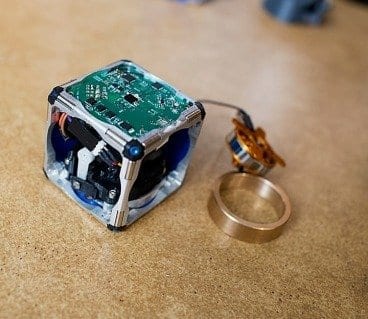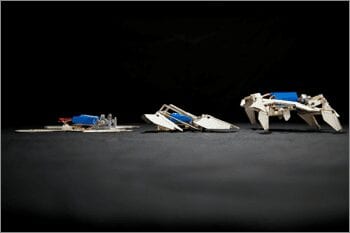
Small cubes with no exterior moving parts can propel themselves forward, jump on top of each other, and snap together to form arbitrary shapes.
In 2011, when an MIT senior named John Romanishin proposed a new design for modular robots to his robotics professor, Daniela Rus, she said, “That can’t be done.”
Two years later, Rus showed her colleague Hod Lipson, a robotics researcher at Cornell University, a video of prototype robots, based on Romanishin’s design, in action. “That can’t be done,” Lipson said.
In November, Romanishin — now a research scientist in MIT’s Computer Science and Artificial Intelligence Laboratory (CSAIL) — Rus, and postdoc Kyle Gilpin will establish once and for all that it can be done, when they present a paper describing their new robots at the IEEE/RSJ International Conference on Intelligent Robots and Systems.
Known as M-Blocks, the robots are cubes with no external moving parts. Nonetheless, they’re able to climb over and around one another, leap through the air, roll across the ground, and even move while suspended upside down from metallic surfaces.
Inside each M-Block is a flywheel that can reach speeds of 20,000 revolutions per minute; when the flywheel is braked, it imparts its angular momentum to the cube. On each edge of an M-Block, and on every face, are cleverly arranged permanent magnets that allow any two cubes to attach to each other.
“It’s one of these things that the [modular-robotics] community has been trying to do for a long time,” says Rus, a professor of electrical engineering and computer science and director of CSAIL. “We just needed a creative insight and somebody who was passionate enough to keep coming at it — despite being discouraged.”
Embodied abstraction
As Rus explains, researchers studying reconfigurable robots have long used an abstraction called the sliding-cube model. In this model, if two cubes are face to face, one of them can slide up the side of the other and, without changing orientation, slide across its top.
The sliding-cube model simplifies the development of self-assembly algorithms, but the robots that implement them tend to be much more complex devices. Rus’ group, for instance, previously developed a modular robot called the Molecule, which consisted of two cubes connected by an angled bar and had 18 separate motors. “We were quite proud of it at the time,” Rus says.
According to Gilpin, existing modular-robot systems are also “statically stable,” meaning that “you can pause the motion at any point, and they’ll stay where they are.” What enabled the MIT researchers to drastically simplify their robots’ design was giving up on the principle of static stability.
“There’s a point in time when the cube is essentially flying through the air,” Gilpin says. “And you are depending on the magnets to bring it into alignment when it lands. That’s something that’s totally unique to this system.”
That’s also what made Rus skeptical about Romanishin’s initial proposal. “I asked him build a prototype,” Rus says. “Then I said, ‘OK, maybe I was wrong.’”
Sticking the landing
To compensate for its static instability, the researchers’ robot relies on some ingenious engineering. On each edge of a cube are two cylindrical magnets, mounted like rolling pins. When two cubes approach each other, the magnets naturally rotate, so that north poles align with south, and vice versa. Any face of any cube can thus attach to any face of any other.
The cubes’ edges are also beveled, so when two cubes are face to face, there’s a slight gap between their magnets. When one cube begins to flip on top of another, the bevels, and thus the magnets, touch. The connection between the cubes becomes much stronger, anchoring the pivot. On each face of a cube are four more pairs of smaller magnets, arranged symmetrically, which help snap a moving cube into place when it lands on top of another.
As with any modular-robot system, the hope is that the modules can be miniaturized: the ultimate aim of most such research is hordes of swarming microbots that can self-assemble, like the “liquid steel” androids in the movie “Terminator II.” And the simplicity of the cubes’ design makes miniaturization promising.
But the researchers believe that a more refined version of their system could prove useful even at something like its current scale. Armies of mobile cubes could temporarily repair bridges or buildings during emergencies, or raise and reconfigure scaffolding for building projects. They could assemble into different types of furniture or heavy equipment as needed. And they could swarm into environments hostile or inaccessible to humans, diagnose problems, and reorganize themselves to provide solutions.
Strength in diversity
The researchers also imagine that among the mobile cubes could be special-purpose cubes, containing cameras, or lights, or battery packs, or other equipment, which the mobile cubes could transport. “In the vast majority of other modular systems, an individual module cannot move on its own,” Gilpin says. “If you drop one of these along the way, or something goes wrong, it can rejoin the group, no problem.”
“It’s one of those things that you kick yourself for not thinking of,” Cornell’s Lipson says. “It’s a low-tech solution to a problem that people have been trying to solve with extraordinarily high-tech approaches.”
The Latest Bing News on:
Self-assembling robots
- Simbe partners with Plexus to scale Tally inventory roboton May 9, 2024 at 6:52 am
Simbe Robotics, which said it recorded a 3x increase in its subscription revenue in 2023, is scaling production of its Tally inventory robot.
- We got our hands on Dyson’s new robot vacuum, the 360 Vis Nav. Here’s our reviewon May 8, 2024 at 10:31 am
Its suction power and edge cleaning capabilities are impressive, but it lacks features like mopping and self-emptying that we'd expect ... the back of the docking base and shove the robot into its ...
- Comau presents its new S-Family of small, fast and element-resistant “hollow wrist” industrial robotson May 8, 2024 at 7:40 am
Comau debuts its new S-Family of small yet powerful robots at Automate 2024 in Chicago, Illinois. The first two high-speed robots, with payloads of 13 kg and up to 18 kg, are expressly indicated for ...
- Magnetic microrobot swarms clean water of microplastics and bacteriaon May 8, 2024 at 6:02 am
Microplastics are one of the biggest environmental and health risks faced by our generation. Now, researchers have developed swarms of tiny robots, or microrobots, that not only microplastics from ...
- These astonishing biobots can help neurons regrow — but researchers have no idea howon May 7, 2024 at 12:57 am
Scientists have created tiny, self-assembling robots made from human cells that could one day repair damaged skin and tissue. These tiny biological machines, called Anthrobots, are made from human ...
- Commentary: How robots making your burger and fries can lead to greater income inequalityon May 6, 2024 at 1:00 am
On April 1, more than half a million fast-food workers in California got a raise, with minimum wage across the sector bumped up to $20 per hour. That same week, ...
- Robotics, Sustainability, Resiliency Are Standards For Future Homeson May 3, 2024 at 6:01 am
Three startups demonstrate that technology and automation can be used to produce homes faster, at lower costs and with better performance.
- A Roundup of New Robotson May 1, 2024 at 6:16 am
The cups are available in four diameters, from 40 to 100 millimeters, and three mounting configurations (3/8G male or female and 32 millimeter square). All are made from thermoplastic polyurethane for ...
- Best Robot Vacuums for 2024on April 26, 2024 at 7:15 am
We've picked out the best robot vacuums after putting them through extensive testing methodologies we've fine-tuned over the years. Originally hailing from Troy, Ohio, Ry Crist is a writer ...
- Whisker Litter-Robot 4 review: This $700 self-cleaning litter box outperformed every other box we testedon April 23, 2024 at 5:00 pm
In addition to using the Whisker Litter-Robot 4 since 2022, I have also tested eight other boxes for our guide to the best self-cleaning litter boxes. For weeks, I took notes as my cats circled ...
The Latest Google Headlines on:
Self-assembling robots
[google_news title=”” keyword=”Self-assembling robots” num_posts=”10″ blurb_length=”0″ show_thumb=”left”]
The Latest Bing News on:
Self-assembling robot
- Simbe partners with Plexus to scale Tally inventory roboton May 9, 2024 at 6:52 am
Simbe Robotics, which said it recorded a 3x increase in its subscription revenue in 2023, is scaling production of its Tally inventory robot.
- We got our hands on Dyson’s new robot vacuum, the 360 Vis Nav. Here’s our reviewon May 8, 2024 at 10:31 am
Its suction power and edge cleaning capabilities are impressive, but it lacks features like mopping and self-emptying that we'd expect ... the back of the docking base and shove the robot into its ...
- Magnetic microrobot swarms clean water of microplastics and bacteriaon May 8, 2024 at 6:02 am
Microplastics are one of the biggest environmental and health risks faced by our generation. Now, researchers have developed swarms of tiny robots, or microrobots, that not only microplastics from ...
- These astonishing biobots can help neurons regrow — but researchers have no idea howon May 7, 2024 at 12:57 am
Scientists have created tiny, self-assembling robots made from human cells that could one day repair damaged skin and tissue. These tiny biological machines, called Anthrobots, are made from human ...
- Commentary: How robots making your burger and fries can lead to greater income inequalityon May 6, 2024 at 1:00 am
On April 1, more than half a million fast-food workers in California got a raise, with minimum wage across the sector bumped up to $20 per hour. That same week, ...
- Robotics, Sustainability, Resiliency Are Standards For Future Homeson May 3, 2024 at 6:01 am
Three startups demonstrate that technology and automation can be used to produce homes faster, at lower costs and with better performance.
- This Eufy self-emptying robot vacuum is over 50% offon May 2, 2024 at 5:00 pm
With 2,000Pa suction power, Wi-Fi connectivity, planned pathfinding, and the ability to self-empty, the Eufy 30+ offers features of a $400+ robot vacuum, but it's currently on sale for $197.
- A Roundup of New Robotson May 1, 2024 at 6:16 am
The cups are available in four diameters, from 40 to 100 millimeters, and three mounting configurations (3/8G male or female and 32 millimeter square). All are made from thermoplastic polyurethane for ...
- Best Robot Vacuums for 2024on April 26, 2024 at 7:15 am
We've picked out the best robot vacuums after putting them through extensive testing methodologies we've fine-tuned over the years. Originally hailing from Troy, Ohio, Ry Crist is a writer ...
- Will Robots Replace Warehouse Workers?on April 25, 2024 at 6:27 am
Robots are transforming the warehouse & manufacturing industry. From efficient order fulfilment to job security, learn what roles are safe amidst automation.
The Latest Google Headlines on:
Self-assembling robot
[google_news title=”” keyword=”Self-assembling robot” num_posts=”10″ blurb_length=”0″ show_thumb=”left”]










